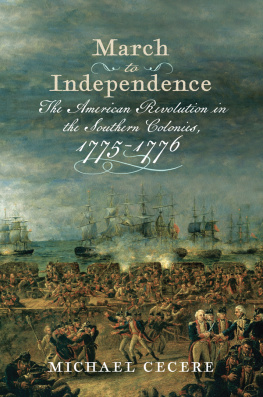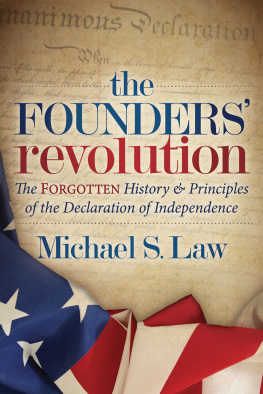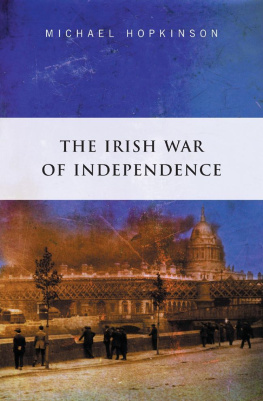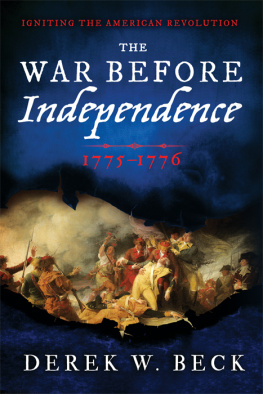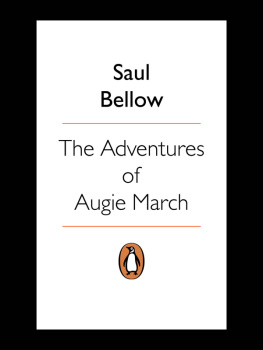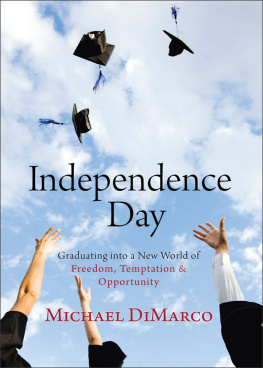Michael Cecere - March to Independence
Here you can read online Michael Cecere - March to Independence full text of the book (entire story) in english for free. Download pdf and epub, get meaning, cover and reviews about this ebook. publisher: Westholme Publishing, genre: Politics. Description of the work, (preface) as well as reviews are available. Best literature library LitArk.com created for fans of good reading and offers a wide selection of genres:
Romance novel
Science fiction
Adventure
Detective
Science
History
Home and family
Prose
Art
Politics
Computer
Non-fiction
Religion
Business
Children
Humor
Choose a favorite category and find really read worthwhile books. Enjoy immersion in the world of imagination, feel the emotions of the characters or learn something new for yourself, make an fascinating discovery.
- Book:March to Independence
- Author:
- Publisher:Westholme Publishing
- Genre:
- Rating:4 / 5
- Favourites:Add to favourites
- Your mark:
- 80
- 1
- 2
- 3
- 4
- 5
March to Independence: summary, description and annotation
We offer to read an annotation, description, summary or preface (depends on what the author of the book "March to Independence" wrote himself). If you haven't found the necessary information about the book — write in the comments, we will try to find it.
March to Independence — read online for free the complete book (whole text) full work
Below is the text of the book, divided by pages. System saving the place of the last page read, allows you to conveniently read the book "March to Independence" online for free, without having to search again every time where you left off. Put a bookmark, and you can go to the page where you finished reading at any time.
Font size:
Interval:
Bookmark:

Journal of the American Revolution Books highlight the latest research on new or lesser-known topics of the revolutionary era. The Journal of the American Revolution is an online resource and annual volume that provides educational, peer-reviewed articles by professional historians and experts in American Revolution studies.
Other Titles in the Series
1764: The First Year of the American Revolution
by Ken Shumate
Anatomy of a Massacre: The Destruction of Gnadenhutten, 1782
by Eric Sterner
The Burning of His Majestys Schooner Gaspee: An Attack on Crown Rule Before the American Revolution
by Steven Park
General Peter Muhlenberg: A Virginia Officer of the Continental Line
by Michael Cecere
Grand Forage 1778: The Battleground Around New York City
by Todd W. Braisted
The Invasion of Virginia 1781
by Michael Cecere
John Adams vs. Thomas Paine: Rival Plans for the New Republic
by Jett B. Connor
The Road to Concord: How Four Stolen Cannon Ignited the Revolutionary War
by J. L. Bell
Washingtons War, 1779
by Benjamin Lee Huggins
2021 Michael Cecere
Maps by Tracy Dungan. 2021 Westholme Publishing
All rights reserved under International and Pan-American Copyright Conventions. No part of this book may be reproduced in any form or by any electronic or mechanical means, including information storage and retrieval systems, without permission in writing from the publisher, except by a reviewer who may quote brief passages in a review.
Westholme Publishing, LLC
904 Edgewood Road
Yardley, Pennsylvania 19067
Visit our Web site at www.westholmepublishing.com
ISBN: 978-1-59416-684-6
Also available in hardback.
Produced in the United States of America.
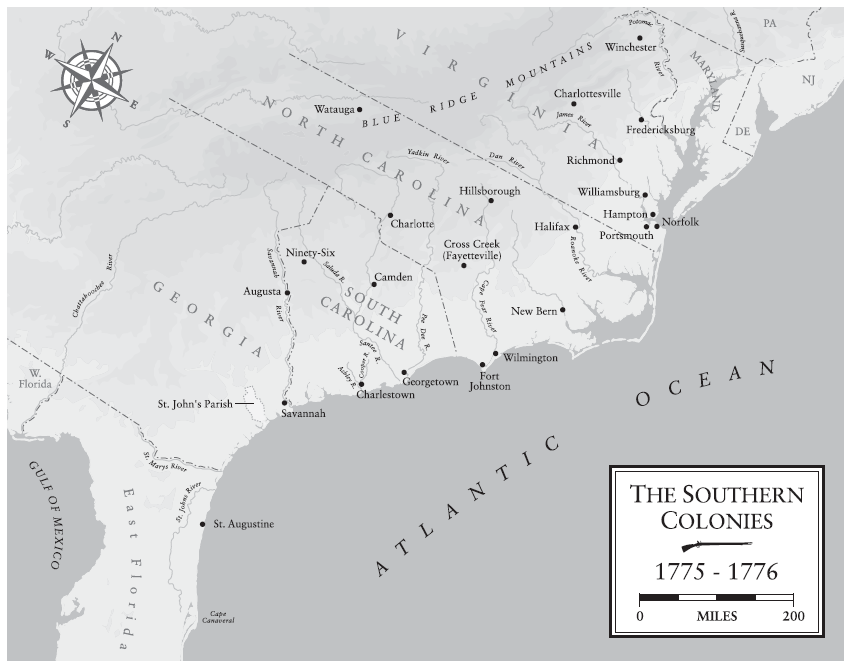
The Southern Colonies on the Eve of the Revolution
IT IS UNIVERSALLY UNDERSTOOD THAT THE REVOLUTIONARY WAR in America began in Lexington, Massachusetts, on April 19, 1775, when the shot heard around the world triggered a bloody engagement between Massachusetts minutemen and British redcoats. The bloodshed at Lexington and Concordgoes the thinkingprompted the other American colonies to join Massachusetts in a long war for independence that initially centered in New England in 1775, then in the mid-Atlantic states from 1776 to 1779, and finally in the southern states from 1780-1781.
Setting aside the complex political issues of 1775, the progression of the Revolutionary War did, as far as large military engagements go, seem to unfold in a sort of regional pattern from the north to the south (with frequent conflict in the western frontier after 1775). However, by compartmentalizing the war into separate theaters of action during distinct periods of time, we tend to overlook the events that occurred in each region outside of their prescribed time period.
For instance, a search of scholarship on the Revolutionary War in the South will produce a number of fine works on the war in that region from 1778 (when the British captured Savannah) through 1781 (ending with Yorktown). Some focus on particular battles like Cowpensor Yorktown while others look at the war in general in the South or in a particular southern state for that time period (or a portion of that time period).
The consequence of placing so much attention on the war in the South from 1778 onward is that people assume that nothing happened in the southern states before 1778. There is a dearth of writing on the Revolutionary War in the South prior to 1778.
At the time of its occurrence, the American Revolution was not the singular movement coordinated by the Continental Congress, as it is often viewed, but rather thirteen separate revolutions within each rebellious colony. Circumstances, necessity, and choice ultimately brought the colonies closer together, but the realities of the age also meant that each colony was often isolated from the other at important times and in important ways. To better understand and appreciate the American Revolution, it is essential to understand what occurred in each individual American colony.
This work attempts to address the lack of attention on the southern colonies in the early part of the Revolutionary War by focusing on the significant events that occurred in Virginia, North Carolina, South Carolina, Georgia, and Florida during the sixteen months from the outbreak of war in April 1775 through the summer of 1776 when independence was declared. Readers will discover that the story of the American Revolution and the Revolutionary War in the southern colonies was a bit more eventful and complex than they realized.
VIRGINIA
In 1775 the population of Virginia, the largest of Britains North American colonies, numbered over half a million people, approximately 40 percent of whom were enslaved.
Virginias reliance on the production of tobacco influenced its development and settlement. Large tracts of cultivated land were necessary Within Williamsburg, however, assembled some of Americas greatest Revolutionary leaders: Patrick Henry, Thomas Jefferson, George Washington, Peyton Randolph, George Mason, and Richard Henry Lee, just to name a few. It is impossible to overstate the contribution these Virginians made to the formation of the United States.
NORTH CAROLINA
North Carolinas population in 1775 was approximately 240,000, with about a quarter of the population enslaved. A large number of North Carolinians were settled in the interior counties of the colony by 1775 where cash crops were more difficult to grow and get to market. As a result, North Carolina was significantly less affluent than either Virginia or South Carolina, which was the chief exporter of the third most valuable colonial commodity, rice.
Like Virginia, there were no large settlements to speak of in North Carolina, although Wilmington was a busy port on the Cape Fear River and New Bern was the capital. A significant rift existed between those colonists who lived in the eastern part of the colony, some of whom were large land and slave owners, and those who lived a more subsistence lifestyle in the interior of the colony. In fact, in 1771, bloodshed erupted between North Carolinians when disgruntled colonists from the backcountry, dubbed regulators, rose up in opposition against corrupt local authorities. Governor William Tryon led militia from the eastern counties to confront the defiant regulators and crushed their ill-planned uprising.
Tryon moved on to govern New York, and most of the regulators were pardoned after pledging loyalty to the crown, but the animosity between eastern and western colonists in North Carolina remained just under the surface.
SOUTH CAROLINA
Over 150,000 people lived in South Carolina in 1775, well over half of whom were enslaved. South Carolina broke the pattern of most cash croporiented colonies by having the fourth largest city in the American colonies, Charlestown. It was through Charlestown that the very valuable commodities of South Carolina plantations and farms in the lowcountry, rice and indigo, were exported. The production of these exports was the result of the hard work of the colonys large and growing slave population, which easily surpassed the White population of South Carolina.
Reliance on the forced labor of over half the population made free, White South Carolinians vulnerable to, and hypervigilant toward, any possibility of a slave insurrection. This constant concern, and their economic dependence on trade with Great Britain, did not dampen South Carolinas determination to resist Parliaments unconstitutional policies toward the American colonies. This determination, however, was not shared by all free South Carolinians. Many of those who lived in the backcountry of South Carolina strongly resented the gentlemen planters of the lowcountry, who profited immensely from the cultivation of rice and indigo raised largely by slave labor and who held all of the political power in the colony. A regulator movement similar to that in North Carolina had also developed in South Carolina in the 1760s, and on the eve of the Revolutionary War the resentment and distrust of the lowcountry gentlemen that spawned this movement lingered among many colonists in the backcountry.
Font size:
Interval:
Bookmark:
Similar books «March to Independence»
Look at similar books to March to Independence. We have selected literature similar in name and meaning in the hope of providing readers with more options to find new, interesting, not yet read works.
Discussion, reviews of the book March to Independence and just readers' own opinions. Leave your comments, write what you think about the work, its meaning or the main characters. Specify what exactly you liked and what you didn't like, and why you think so.

